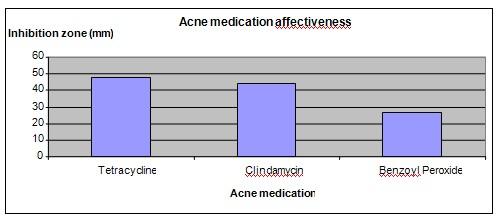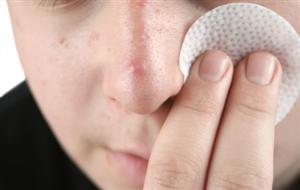| Complexity level: | 7 |
| Project cost ($): | 50 |
| Time required: | 1 day for preparation, 4 days for the science project experiment |
| Material availability: | Access to laboratory equipment (eg. petri dishes) |
| Safety concerns: | Always follow laboratory safety guidelines and always practice sterile technique when handling microbes. Never have any food or drink at your workstation and always thoroughly wash your hands with disinfectant soap or alcohol before leaving your workstation. Always dispose of used material in a biohazard bag. If none are available, the bacteria should be destroyed with bleach before being disposed of. |
Hypothesis
Acne medications effectively inhibit the growth of bacteria that causes acne.
Overview
Acne
Acne occurs in the pilosebaceous unit that consists of a hair shaft, a sebaceous gland and a hair follicle. These units are present in higher numbers on our face, neck and chest areas. These sebaceous glands help keep our hair and skin moisturized by producing a substance called sebum.
Propionibacterium acne (P. acne) bacteria are normally found living on the surface of our skin. It uses the sebum produced by the sebaceous gland as a nutrient for its survival . People with acne problems have greater amounts of P. acne in their follicles. White blood cells are attracted to the presence of P. acne and they release an enzyme that damage the follicle walls. This process causes inflammation which is aggravated by the presence of fatty acids produced by P. acne.
Among the common acne medications are Tetracycline which helps in reducing the inflammatory lesions. Clindamycin is an antibiotic that helps to destroy P. acne and alleviate inflammations. Benzoyl peroxide helps destroy P. acne but does not have anti-inflammatory properties.
Scientific Terms
Materials
The materials required for this science fair project are:
- 3 Petri dishes prepared with agar
- 1 disinfected swab
- 1 bottle of disinfected water
- A piece of filter paper
- A hole puncher
- 4 test tubes
- 1 measuring cylinder
- 1 pippette with disposable tips
- Tetracycline
- Clindamycin
- Benzoyl peroxide (a pharmacist will be able to supply you with all 3 types of medication)
- 1 beaker of water
- P. acne bacteria culture - check with your laboratory
- 1 forcep
- 1 digital weighing scale
- 1 marker pen
Procedure
1. The independent variable of this science fair project is the type of acne medication used - Tetracycline, Clindamycin and Benzoyl peroxide. The dependent variable is the size of the inhibition zone (the area free of bacteria). This is determined by measuring the diameter of the area using a ruler. The constants (control variables) are the room temperature, the concentration of the medication and the ingredients in the Petri dish .
2. Three Petri dishes are prepared using the agar and stored in the refrigerator. The Petri dishes are brought to room temperature before the start of experiment by removing them from the refrigerator. . The Petri dishes are labeled with the names of the acne medicationsTetracycline, Clindamycin and Benzoyl peroxide.
3. Using the pippette, mix the respective acne medications with water and label them accordingly:
a. Marked Tetracycline - 5mg of Tetracycline is mixed with 10ml water
b. Marked Clindamycin - 5mg of Clindamycin is mixed with 10ml water
c. Marked Benzoyl peroxide - 5mg of Benzoyl peroxide is mixed with 10ml water
Use 3 of the test tubes to contain each sample of diluted medication.
4. Mix the fourth test tube containing 10ml of P. acne bacterium with 40ml of water. The swab is washed with disinfected water and dipped into the test tube containing the bacteria before gently swabbed all over the agar surface of the 3 Petri dishes. Ensure that you swab in at least 3 directions to cover the entire surface of the dishes.
5. Using the hole puncher, punch out circular discs of filter paper . Pick up the filter paper discs using the sterile forceps and dip it into the test tubes containing the acne medications. The discs are then placed in the center of the correctly labeled Petri dish. Close the cover of the dish. The Petri dishes are kept in a cool, shaded place for the next four days for the bacteria to grow.
6. 4 days later, there will be a circular area around the filter paper called the inhibition zone where there is no bacterial growth. The diameter of this area is measured and recorded in the table provided below. The term "inhibition zone" comes from the Kirby-Bauer disk diffusion method. This method is used by microbiologists to assess the effectiveness of antimicrobial agents. As the antibacterial agent diffuses out from the filter paper into the agar, there will be a higher concentration of antibacterial agent nearer the disk. This concentration decreases gradually, as the distance from the edge of the disc increases. As long as the concentration of d antibacterial agent at any given distance is high enough to properly act as an antibacterial agent, no bacteria will grow at that location. Hence, if the bacteria has increased resistance, a smaller inhibition zone will be seen, and vice versa.

Results
The results show that all 3 anti-acne medications are able to inhibit the growth of the P. acne but the use of Tetracycline medication resulted in the largest inhibition zone.
| Medication | Tetracycline | Clindamycin | Benzoyl Peroxide |
| Inhibition zone (mm) | 48 | 44 | 27 |
Plot the results of your observation into a graph, as shown below

Conclusion
The hypothesis that acne medications will inhibit the growth of acne causing bacteria (P.acne), is proven to be true.
There are many types of medication available for treating acne. A mild acne condition can be treated using topical creams. . More severe and persistent conditions may require oral antibiotics that assist in the alleviation of skin inflammation and in reducing the population of P. acne bacteria.
Also consider
This science fair project can be repeated by varying the types of P. acne medications used like Erythromycin, Azelaic acid and Oregano oil.
Will the antibacterial agents be more or less effective at varying ambient temperature conditions? What about humidity? How does that affect the rate of bacteria growth?
References
What causes acne? - http://dermatology.about.com/cs/acnebasics/a/acnecause.htm
Prescription medications for treating acne - http://www.who.int/mediacentre/factsheets/fs194/en/

